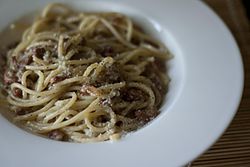Origin and etymology
According to one hypothesis, the name of the dish is derived from the Romanesco word gricio; in papal Rome, the grici were sellers of common foods. [2] They got this name because many of them came from Valtellina, at that time a possession of the Swiss canton of Grigioni. [2] Thus pasta alla gricia refers to "pasta prepared with simple ingredients available at the local gricio" (guanciale, pecorino romano , and black pepper).
Others theorize that the dish was invented in Grisciano, Lazio, near Amatrice, the origin of Amatriciana sauce. Buccini (2007) argues that this theory is more probably correct, citing the name spaghetti alla marchigiana from the 1920s, referring to the neighboring region of Le Marche. If this theory is correct, the name started as alla grisciana, then modified to alla gricia to fit the occupational theme of puttanesca , scarpariello , carbonara and carrettiera . [3] In Amatrice as late as the 1960s amatriciana sauce was prepared without tomato, coinciding with gricia. [4] Gricia is also named amatriciana bianca.
This page is based on this
Wikipedia article Text is available under the
CC BY-SA 4.0 license; additional terms may apply.
Images, videos and audio are available under their respective licenses.
